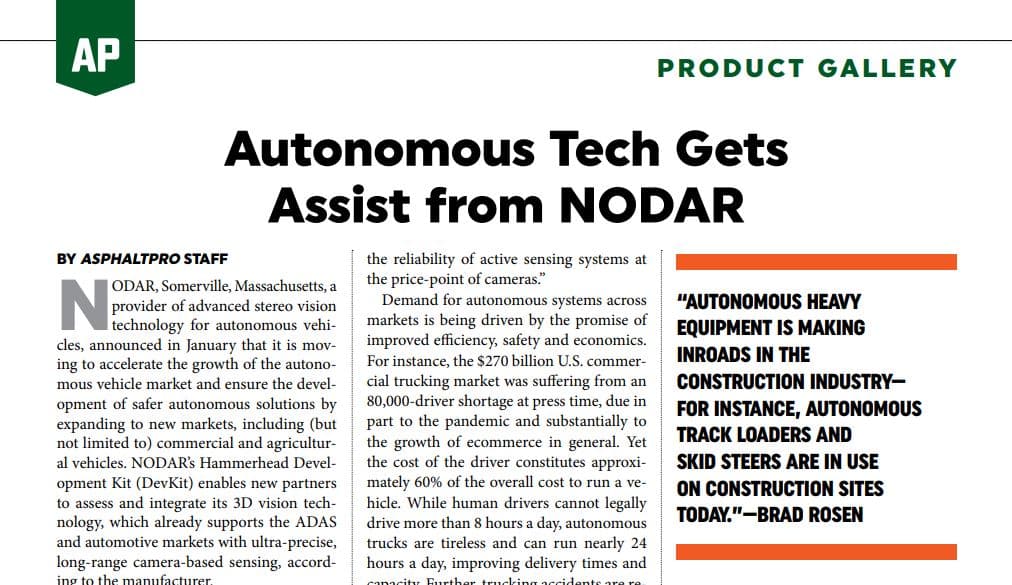Autonomous Tech Gets Assist from NODAR
BY AsphaltPro Staff

NODAR, Somerville, Massachusetts, a provider of advanced stereo vision technology for autonomous vehicles, announced in January that it is moving to accelerate the growth of the autonomous vehicle market and ensure the development of safer autonomous solutions by expanding to new markets, including (but not limited to) commercial and agricultural vehicles. NODAR’s Hammerhead Development Kit (DevKit) enables new partners to assess and integrate its 3D vision technology, which already supports the ADAS and automotive markets with ultra-precise, long-range camera-based sensing, according to the manufacturer.
The NODAR DevKit includes the software, hardware and tools for autonomous systems developers to leverage the benefits of NODAR’s patented Hammerhead™ technology. Hammerhead is an untethered stereo vision software platform that uses images from multiple cameras to produce high-fidelity 3D point clouds in real time. The system detects objects as small as 10 cm at 150 meters away.
Autonomous systems such as construction cranes and farming equipment should benefit from Hammerhead to perceive their environment in real time. Hammerhead’s proprietary online calibration system delivers resilience to extreme vibration, making the system ideal for off-road, commercial and in-air autonomous system applications, according to the manufacturer.
“Every autonomous system must have the ability to ‘see’ and sense its environment in order to avoid obstacles and do path planning,” NODAR CEO Leaf Jiang said. “In the automotive industry, 3D vision is the cornerstone of developing safer autonomous vehicles. Recently, we’ve been hearing increasingly about the automation of robotic systems beyond the automotive market, and that’s very exciting for us. The DevKit we are releasing makes NODAR technology accessible across a wide variety of markets and applications of autonomy, offering the reliability of active sensing systems at the price-point of cameras.”
Demand for autonomous systems across markets is being driven by the promise of improved efficiency, safety and economics. For instance, the $270 billion U.S. commercial trucking market was suffering from an 80,000-driver shortage at press time, due in part to the pandemic and substantially to the growth of ecommerce in general. Yet the cost of the driver constitutes approximately 60% of the overall cost to run a vehicle. While human drivers cannot legally drive more than 8 hours a day, autonomous trucks are tireless and can run nearly 24 hours a day, improving delivery times and capacity. Further, trucking accidents are reported to account for nearly 5,000 fatalities a year in the United States—a number that is expected to decline as autonomous functionality comes online.
“Autonomous heavy equipment is making inroads in the construction industry—for instance, autonomous track loaders and skid steers are in use on construction sites today,” NODAR COO Brad Rosen said. “With lower fuel consumption and reduced emission, self-driving equipment can help meet increasingly strict environmental standards. It can also eliminate human issues like fatigue and distracted driving, and help compensate for the ongoing shortage of skilled labor.”
“Self-driving compaction equipment is likely to join the paving train next,” Rosen continued. “Rollers for asphalt and soil compaction use highly repetitive processes, which can lead to rolling pattern variations as an operator’s attention waivers. By performing repetitive tasks more consistently and precisely, automated equipment can ensure greater layer durability, improving quality while freeing skilled workers for more demanding work and reducing costs. Further, autonomous equipment can have a significant impact on one of the industry’s most important objectives: making asphalt paving sites safer for workers.
“In this context, NODAR’s Hammerhead technology makes it possible to operate more safely and reliably in a challenging environment where the terrain and surroundings are different every day, the temperatures can reach high levels, and where the vehicles and road cause significant vibration. The system’s camera-based advanced stereo vision helps heavy equipment identify potential hazards, accurately detect where objects and hazards are located, and navigate safely with resiliency to dust and vibrations as the equipment moves across bumpy sites. The use of high-performance 3D vision in autonomous heavy equipment helps improve productivity and reduce overall operational costs as well.”
As with autonomous vehicles and trucks, NODAR’s platform benefits all these new markets with its support for independently mounted cameras and wide baseline configurations, offering camera-based resolution, a small footprint, and the sensing reliability of LiDAR. NODAR’s new Hammerhead DevKit contains everything customers need to set up and begin using the system in a matter of minutes, according to the manufacturer.
For more information, contact sales@nodarsensor.com or www.nodarsensor.com/dev-kit.
“Autonomous heavy equipment is making inroads in the construction industry—for instance, autonomous track loaders and skid steers are in use on construction sites today.”—Brad Rosen
BOMAG Designs BW 174 AP-5 AM Hybrid for Tandem Roller Efficiency
CNH Industrial Reman Offers Remanufactured Engines for Case, New Holland Mini Excavators
